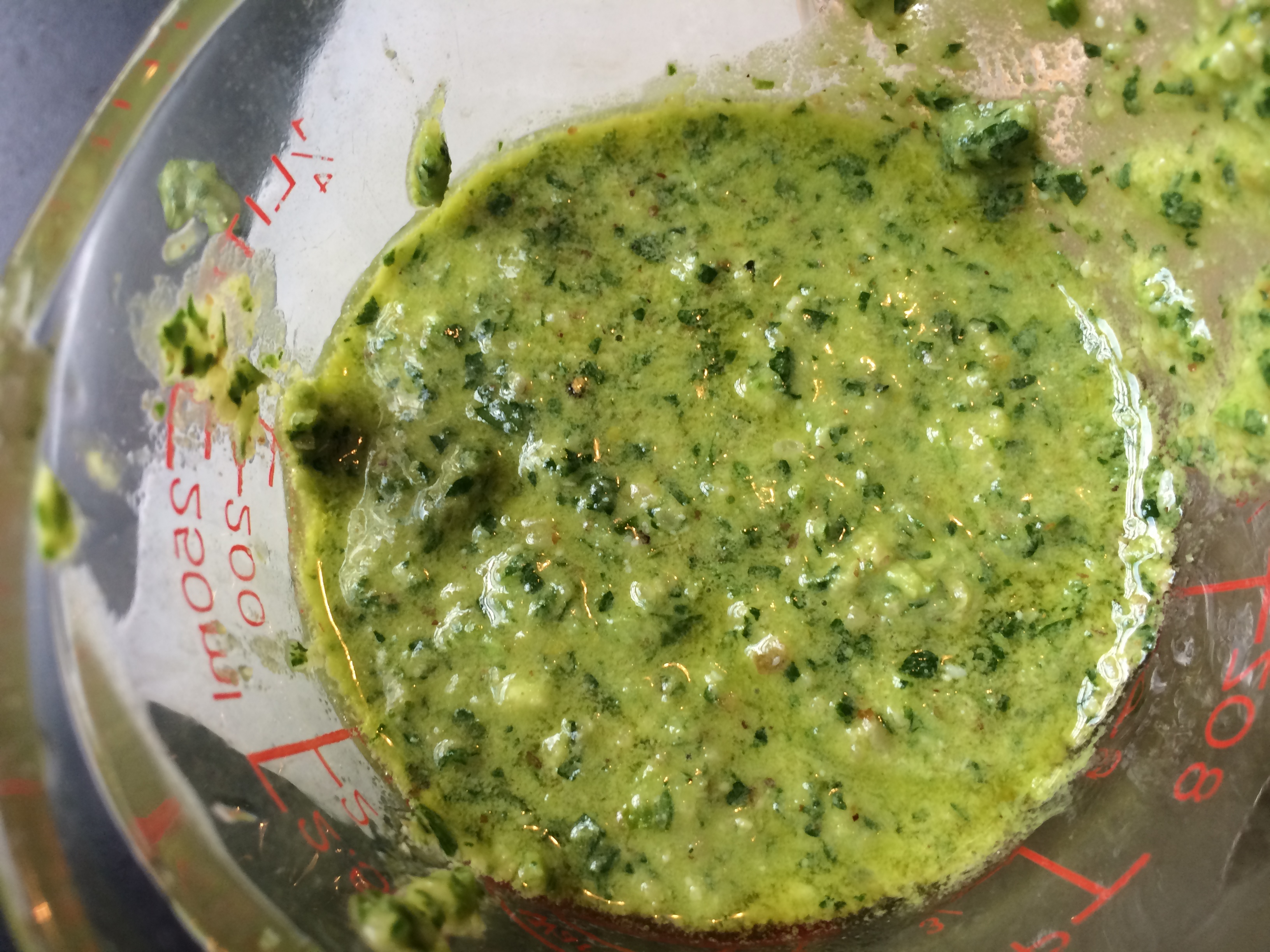Presto! It's Pesto!
carrie
I know I'm a bit premature with my proclamation that we're getting close to pesto season, but we'll be greeted by market fresh herbs and greens such as ramps, sorrel and garlic scapes before you know it. Pesto, once you've got the hang of it, is endlessly adaptable: It's just waiting to be tossed with some pasta water with the shape of your choice, spread on a sandwich or around the base of a pizza, or used as a rustic crudite dip. (Ian, this one's for you—it's easily veganized, and I know you have a food processor.)
First things first: Pesto means sauce. It does not always necessarily by definition mean you have to use basil. Okay? Ok. You can even make pesto out of broccoli stalks (what my sister and I used to call tree trunks) and kale ribs (just steam 'em a bit first).
Secondly, I'm putting this forward as something of a loose template, with some caveats. Obviously, if you are on a budget you will look at the price of pine nuts and shudder. If you are following a vegan diet, you'll want to sub some nutritional yeast for the cheese factor; just dial it back a bit in terms of the amount. And if you are allergic to nuts and following a vegan diet? You'll want to use nutritional yeast and sunflower seeds; the latter tend to get nutty when you grind them. Celiac or gluten sensitive? Stay the hell away from nutritional yeast, but you probably already knew that.
Here's a combo I happen to like: parsley-walnut pesto. I think of it as an all-year round pesto, simply because I can obtain organic parsley easily and it's one of those herbs I buy regularly without fail and all year round, along with cilantro, thyme and rosemary. (I don't buy basil in the winter because then tomatoes and mozzarella should hang out there, too, and I can't eat a Caprese salad in January. I. just. can't.) This couldn't be simpler. If you're making this for dinner or another meal, you can complete these steps while the pasta boils.
Parsley-Walnut Pesto
Ingredients
- 2 cups fresh parsley, stems included, loosely packed
- 1-2 cloves garlic
- 1/4 cup walnuts (you can toast in a dry pan over medium heat till they're fragrant first if you like)
- 1/4 cup Locatelli Romano cheese
- Zest and juice of one whole organic lemon
- 1/3 cup extra virgin olive oil
- Kosher salt and freshly ground pepper to taste
Directions
1. Place the parsley through lemon zest and juice into the bowl of a food processor, and pulse a few times to combine. Stop the machine, taste the mixture, and add a couple of good pinches of salt and several grinds of black pepper. Switch it back on and, using the funnel, pour the olive oil into the food processor and let it go for about 15-20 seconds. It won't take long to come together.
2. Remove the lid and taste the pesto, adjusting seasonings to ensure a fresh, bright and fairly smooth taste. Yield: About 6 ounces or about 2/3 cup.
3. Let's assume your pasta is ready. Remove it from the boiling water with a spider strainer into a large serving bowl. Scoop your 1-cup glass measuring cup into the pot to get about 1/2 cup of hot pasta water. Dump the remaining water out into the sink, return the pasta to the hot pot, add as much pesto as you like (I used about 3 ounces of pesto for 8 ounces of uncooked pasta), and stir to combine. Slowly add the reserved hot pasta water, and stir it all together fairly vigorously. Transfer to your serving bowl and hit it with some grated cheese (please, not the kind in the green can.)
A few words about the pasta. For pesto, I like to use a shape with lots of nooks and crannies, like the gluten-free "garden pagoda" veggie pasta you see here, but anything will work, really. In the last 2 minutes of cooking I added 1/2 cup frozen peas to the pasta water, and then once everything was in the hot pan with the pesto, I added about 8 ounces of thinly sliced organic chicken breast I'd cooked a day or so before.
A few words about pesto. Sometimes I see recipes that include some part water (in place of the full amount of olive oil), with the aim of calorie reduction. If you have to do this, please be prepared for a flat experience and a watery pesto; the extra virgin olive oil makes all the difference and lends a fruity, herbal taste (depending somewhat of course on the oil you use.) You can certainly add more olive oil if you like—it's your call. And parents, if you're reading, pesto-based dishes are a really sneaky way to get vitamins, minerals and healthy fats into your children's diet and will typically contain far less sodium than jarred, store-bought tomato sauce. If you've made baby food before, you know that pureed veggies and herbs, if prepared well, typically go down easily with kids.


